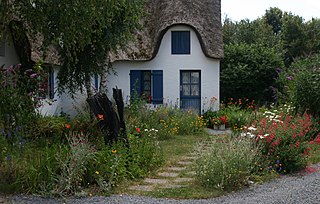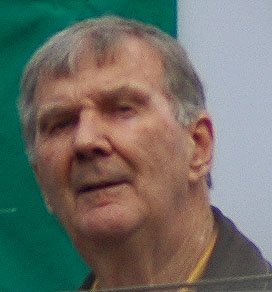Related Research Articles

Gardening is the practice of growing and cultivating plants as part of horticulture. In gardens, ornamental plants are often grown for their flowers, foliage, or overall appearance; useful plants, such as root vegetables, leaf vegetables, fruits, and herbs, are grown for consumption, for use as dyes, or for medicinal or cosmetic use.

Jamie Paul Durie OAM is an Australian horticulturalist and landscape designer, furniture designer, television host, television producer, and author of eleven books on landscape architecture, garden design and lifestyle. He is the founder and director of a design company PATIO Landscape Architecture and Durie Design and also is a 2008 Gold Medal winner at Britain's prestigious Royal Horticultural Society (RHS) Chelsea Flower Show in Chelsea, London for Australian Garden and designed by Durie. As of 2018, Durie has hosted more than 50 design shows around the world.

Permaculture is an approach to land management and settlement design that adopts arrangements observed in flourishing natural ecosystems. It includes a set of design principles derived using whole-systems thinking. It applies these principles in fields such as regenerative agriculture, town planning, rewilding, and community resilience. Permaculture originally came from "permanent agriculture", but was later adjusted to mean "permanent culture", incorporating social aspects. The term was coined in 1978 by Bill Mollison and David Holmgren, who formulated the concept in opposition to Western industrialized methods and in congruence with Indigenous or traditional knowledge.

Forest gardening is a low-maintenance, sustainable, plant-based food production and agroforestry system based on woodland ecosystems, incorporating fruit and nut trees, shrubs, herbs, vines and perennial vegetables which have yields directly useful to humans. Making use of companion planting, these can be intermixed to grow in a succession of layers to build a woodland habitat. Forest gardening is a prehistoric method of securing food in tropical areas. In the 1980s, Robert Hart coined the term "forest gardening" after adapting the principles and applying them to temperate climates.

A wildlife garden is an environment created by a gardener that serves as a sustainable haven for surrounding wildlife. Wildlife gardens contain a variety of habitats that cater to native and local plants, birds, amphibians, reptiles, insects, mammals and so on. Establishing a garden that emulates the environment before the residence was built and/or renders the garden similar to intact wild areas nearby (rewilding) will allow natural systems to interact and establish an equilibrium, ultimately minimizing the need for gardener maintenance and intervention. Wildlife gardens can also play an essential role in biological pest control, and also promote biodiversity, native plantings, and generally benefit the wider environment.

John Martin was an English Romantic painter, engraver and illustrator. He was celebrated for his typically vast and melodramatic paintings of religious subjects and fantastic compositions, populated with minute figures placed in imposing landscapes. Martin's paintings, and the prints made from them, enjoyed great success with the general public—in 1821 Thomas Lawrence referred to him as "the most popular painter of his day"—but were lambasted by John Ruskin and other critics.

John Claudius Loudon was a Scottish botanist, garden designer and author. He was the first to use the term arboretum in writing to refer to a garden of plants, especially trees, collected for the purpose of scientific study. He was marrried to Jane, née Webb, a fellow horticulturalist, and author of science-fiction, fantasy, horror, and gothic stories.

The English landscape garden, also called English landscape park or simply the English garden, is a style of "landscape" garden which emerged in England in the early 18th century, and spread across Europe, replacing the more formal, symmetrical French formal garden which had emerged in the 17th century as the principal gardening style of Europe. The English garden presented an idealized view of nature. Created and pioneered by William Kent and others, the “informal” garden style originated as a revolt against the architectural garden and drew inspiration from paintings of landscapes by Salvator Rosa, Claude Lorrain, and Nicolas Poussin.
A garden designer is someone who designs the plan and features of gardens, either as an amateur or professional. The compositional elements of garden design and landscape design are: terrain, water, planting, constructed elements and buildings, paving, site characteristics and genius loci, and the local climatic qualities.

The Landscape Institute (LI) is a UK based professional body for the landscape profession. Its membership includes landscape architects, urban designers, landscape planners, landscape scientists and landscape managers. The LI also has a category for academic members.

Peter Joseph Cundall, was an English-born Australian horticulturalist, conservationist, author, broadcaster and television personality. He lived in Tasmania's Tamar Valley, and until 2008, at the age of 81, presented the ABC TV program Gardening Australia. Starting in 1967, he presented what is believed to be the world's first gardening talkback radio segment. He was made a Member of the Order of Australia in 2007 "For service to the environment, particularly the protection of wilderness areas in Tasmania, and to horticulture as a presenter of gardening programs on television and radio."

Beth Chatto was an English plantswoman, garden designer and author known for creating and describing the Beth Chatto Gardens near Elmstead Market in the English county of Essex. She wrote several books about gardening under specific conditions and lectured on this in Britain, North America, Australia, the Netherlands and Germany. Her principle of placing the right plant in the right place drew on her husband Andrew Chatto's lifelong research into garden-plant origins.

Edward Kemp was an English landscape architect and an author. Together with Joseph Paxton and Edward Milner, Kemp became one of the leaders in the design of parks and gardens during the mid-Victorian era in England.

The French landscape garden is a style of garden inspired by idealized romantic landscapes and the paintings of Hubert Robert, Claude Lorrain and Nicolas Poussin, European ideas about Chinese gardens, and the philosophy of Jean-Jacques Rousseau. The style originated in England as the English landscape garden in the early 18th century, and spread to France where, in the second half of the 18th century and early 19th century, it gradually replaced the rigidly clipped and geometrical French formal garden.

A gardener is someone who practices gardening, either professionally or as a hobby.

David Glenn is a plantsman and exponent of Dry Climate Gardening in Australia. His garden Lambley is located at Ascot, 12 km North of Ballarat in Victoria, Australia. The development of the garden coincided with the millennial drought experienced throughout much of Eastern Australia over the period 2000 to 2010 and earlier. At the time, the garden was recognised internationally for its innovative use of plant types and forms. It was represented as one of the first really considered responses to the challenges of gardening in the Australian climate without resorting to native plantings. Glenn is acknowledged in some texts for developing the exemplar for dry climate gardening in the southern hemisphere. The noted Australian designer Paul Bangay has described Lambley as "One of the most famous" dry perennial gardens in the world, while New Zealand Gardener magazine has described Lambley as "one of the best examples of gardening with perennials" in the world.
SESL Australia was established in 1983 as Sydney Environmental & Soil Laboratory by Simon Leake. SESL provides independent laboratory testing and advisory services to landscape, horticulture, sport and leisure turf, civil construction, environment, government, mining and the waste industry. It offers sample collection, monitoring, analysis and interpretation of soil, water, plant tissue and wastes. SESL also offers training courses on a range of earth science topics mainly focused on urban horticulture, sport and leisure turf, and environmental water.
Ellis Andrew Stones was an Australian landscape architect of private and public gardens—many displaying naturalistic rockwork—and a conservationist whose work and ideas influenced approaches to public landscaping in Australia. Based in Melbourne, Australia, he was an early proponent of the use of Australian native plants and one of the founding fathers of the Australian landscaping style.
Gerald "Gerry" Daly is an Irish Horticulturist, garden designer and media personality and editor of The Irish Garden magazine. He has featured, over a period of nearly 40 years, on multiple radio and television programmes on RTÉ and BBC Northern Ireland channels, and has contributed, as he still does, regular columns for Irish newspapers and magazines, over more than 30 years, including the Irish Independent, the Sunday Independent and the Farmers Journal.
Mary Reynolds is an Irish gardener, landscape designer, author and public activist, known for being the youngest contestant to win a gold medal at the Chelsea Flower Show. She currently works as an author, designer and environmentalist, and published her first book The Garden Awakening in 2016. Her career as a landscape designer and latter accomplishments inspired the biographical drama Dare to Be Wild (2016).
References
- ↑ The Garden, January 2005, pp. 36-41
- 1 2 Gardens to Visit (14 February 2004). "Beware of the bogeyman". The Daily Telegraph. London. Retrieved 5 December 2011.
- ↑ Your Garden, Summer 2006, p. 135
- ↑ Your Garden, March 2000, p. 38
- ↑ "Gardening Australia - Fact Sheet: Wigandia". Abc.net.au. 26 August 2006. Retrieved 5 December 2011.
- ↑ Martins 'wigandia', William (24 March 2013). "a garden of the sun: My greatest influence..."
- ↑ "Burke's Backyard > Fact Sheets > Wigandia Garden". Burkesbackyard.com.au. Retrieved 5 December 2011.
- ↑ The Garden, January 2005, p. 38
- ↑ Guest, Sarah (2001), Gardens in Australia, New Holland Publishers, p. 100
- ↑ Dasey, Annette (25 January 2008). "When Jamie Durie Met Oprah". Yahoo Lifestyle: Who. Archived from the original on 8 July 2012. Retrieved 5 December 2011.
- 1 2 Lamb, E., 'Award winning', The Warrnambool Standard Magazine, 2 November 2002, p. 3
- 1 2 'Under the volcano', Gardens Illustrated
- ↑ "Gardening Australia - Transcript - Episode 28". Australian Broadcasting Corporation. 26 August 2006. Retrieved 5 December 2011.
- ↑ Harpur, J., 2005, Gardens in Perspective, The Octopus Publishing Group, p. 72
- ↑ Nottle, T., 1996, 'Gardens of the Sun,' Kangaroo Press, Australia
- ↑ "Wigandia: a garden of the sun". View from Federal Twist. 13 March 2014. Retrieved 30 July 2020.
- ↑ Owen, Christopher (10 March 2014). "Garden design, from the outside in".